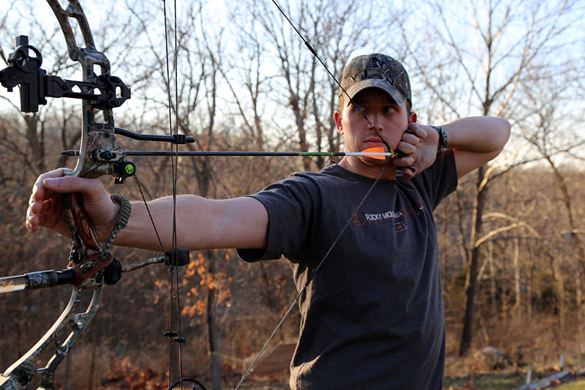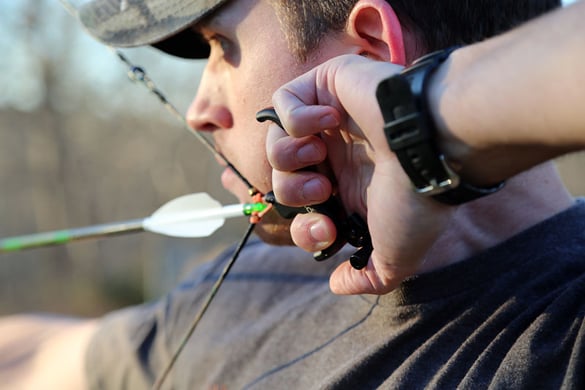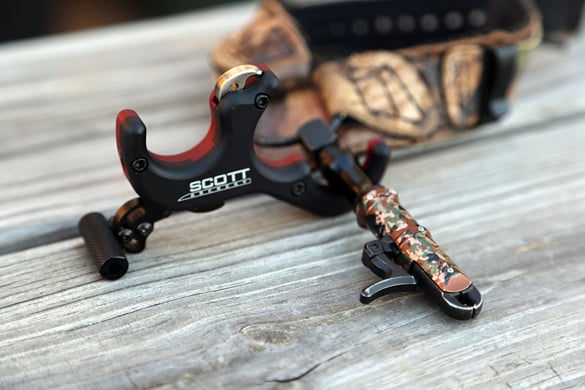LAST UPDATED: May 1st, 2015
Written by Bowhunting.com contributor Mark Huelsing of SoleAdventure.com.
Do you consider yourself an archer, a bowhunter, or both? For a long time I only considered myself a bowhunter. However, the more serious that I became about bowhunting, the more I began to look at all types of archery for inspiration and methods for filling more tags. You may think that punching paper X’s from a mere 20 yards away is a boring, tedious, or even overtly simple task. But, bowhunters can learn a lot from target archers – specifically when it comes to shot execution. (additional practice methods)
Letting Loose
The most common type of release among bowhunters is the wrist-strap, index finger, caliper style release. However, the vast majority of target archers use a handheld release, with a thumb trigger or a hinge (also known as “back tension”) mechanism to fire the shot. If there is one thing I have learned about target archers, it is that they are very particular about their equipment. They are going to choose the gear that helps them execute the best shot; because often the difference between winning and losing a match is not a difference of inches, but of centimeters, or even millimeters. The majority of target archers use handheld releases because it is what helps them make the best shot….. time after time. (2013 Target Archery Products)
There is no doubt that a suprise release will result in better “shot after shot” accuracy. It also helps keep target panic at bay.
Hunting Applications
So, the question at hand is “Can hunters use this type of release in the field? Should they? Will the benefits outweigh the drawbacks”? Well, over the past several months I have been using a handheld thumb-trigger release alongside my “regular” index-finger release. There is no doubt in my mind that the thumb trigger has, and will continue to, improve my shooting. Now, I’m no believer in quick fixes. That fact is that shooting with a thumb trigger initially caused my groups to grow; and I’m still getting used to some aspects of shooting with this type of release. The upside is that I’ve never felt better about my overall form, mindset, and ability to execute a proper shot. That, in my opinion, is worth the perceived setbacks in shooting accuracy. (thoughts from fellow bowhunters)
Any time a change in your shooting routine is applied you can expect an initial slump. However, over the long haul, learning to let your shot happen by surprise will make you more accurate than you ever thought possible.
Defining The Problem
When I refer to shot execution, I am referring to what happens after we draw the bow and before our arrow hits the target. Shot execution is anchoring, aiming, firing, and following through until the arrow reaches the target.
It is common for most bowhunters’ shot execution to somewhat resemble this process – draw the bow, put your hand somewhere on your face, place your string somewhere on your nose, try to get the pin on the target, but hold on, your pin is bouncing everywhere, now the pin is actually on the target (for a split-second), hurry up and pull that trigger! This problem is only encouraged by common index-finger releases, which often have very light triggers that go off in an instant. Because of this, we train ourselves to release the shot on DEMAND….and that’s a bad thing! (target panic)
You don’t have to totally abandon your favorite caliper release to reap the benifits of using a thumb, or “back-tension” release.
Moving to a thumb-trigger release has helped me cure the “oh crap, the pin is on the target, pull the trigger NOW!” feeling, which is otherwise known as target panic. In fact, I don’t even pull the “trigger” on a thumb trigger release. The shot is fired as I hold steady on target and pull through the shot. This “pulling through” is a combination of tightening my back as well as relaxing my release hand, and this movement causes my release to fire. The key to this method is that I’m not sure when the release is going to fire. The shot happens by surprise…..and that is how it should be.
Conclusion
A comfortable, surprise shot isn’t the only advantage to using a thumb-trigger release. In fact, there are several other factors which hunters can benefit from when using this style of release. Stay tuned for Part II, when I will discuss additional benefits of using a handheld release, as well as how to select the right one and how to use it.








